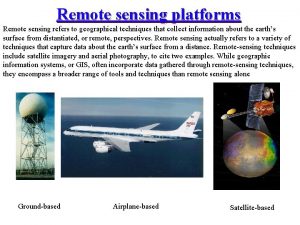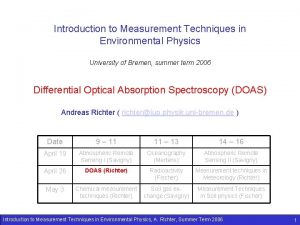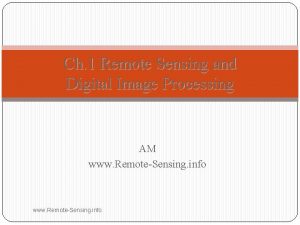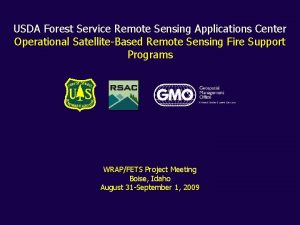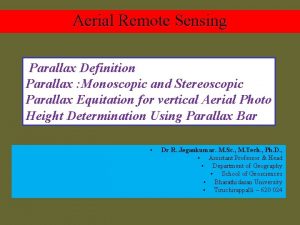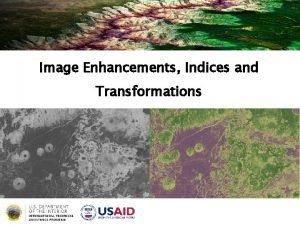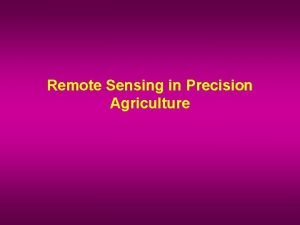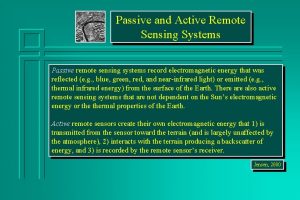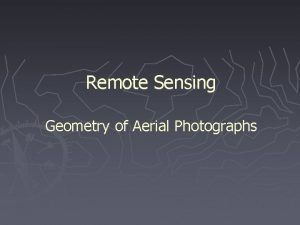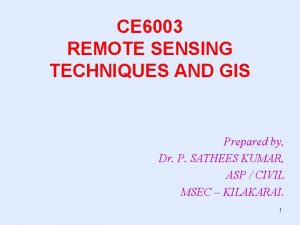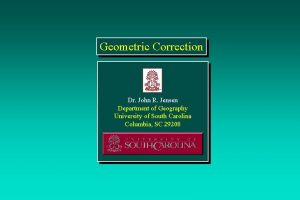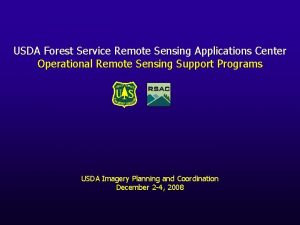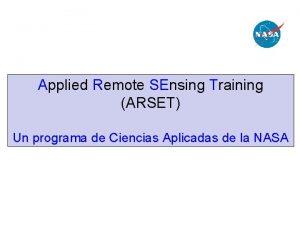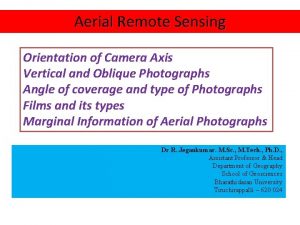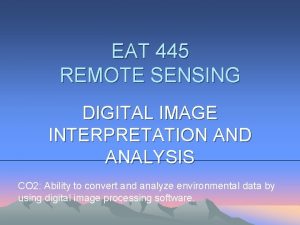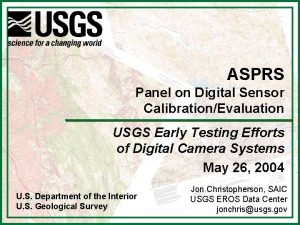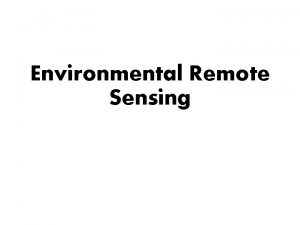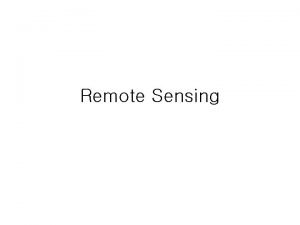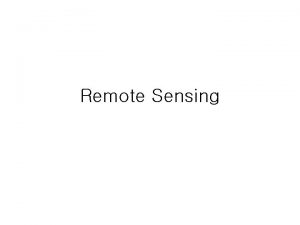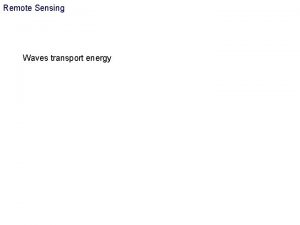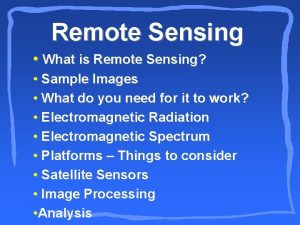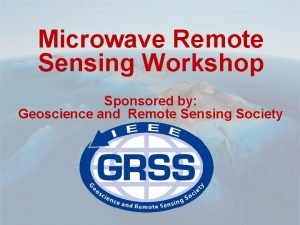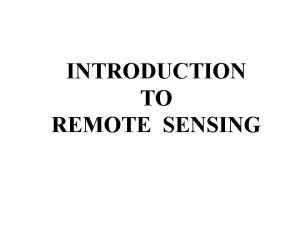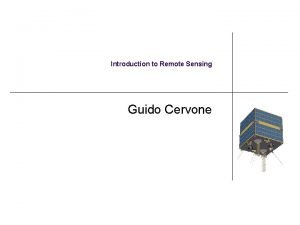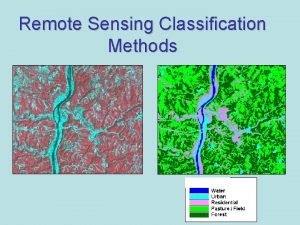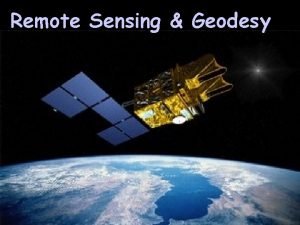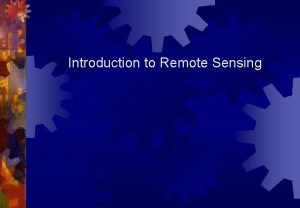ASPRS Panel on USGS Progress on Remote Sensing















- Slides: 15

ASPRS Panel on USGS Progress on Remote Sensing Calibration and Quality Assurance Commercial Remote Sensing (CRS) Characterization, Calibration, Verification, and Validation (C 2 V 2) May 26, 2004 U. S. Department of the Interior U. S. Geological Survey

Background n n n USGS Geography Discipline mission is to provide quality cartographic information for the United States Responsible for calibration of airborne film mapping cameras Recognized as a Center of Excellence by the National and International community 1952 - Multi-collimator built by National Bureau of Standards l 1973 – USGS Optical Science Lab begins camera calibration l 2000 - ASPRS panel of experts recognized the need for digital camera calibration l

Background (cont. ) n n n 2002 - USGS HQ Commercial Imagery Project established, Dr. Lee pushing calibration requirements, the project is currently called CRS C 2 V 2 Project 2003 – USGS EROS Data Center (EDC) digital camera calibration cage and software established 2003 – USGS w/NASA Stennis perform in situ evaluation of digital mapping sensor vendors 2003 – CEOS/ISRPS Joint Task Force on Calibration/Validation, developed Cal Val Terms of Reference 2004 – USGS EDC established an in situ range to compare/characterize digital sensors

ASPRS 10 Year Forecast n “…Industry members hold an optimistic view of the future industry growth, estimating that it will increase by 9 - 14% per year. ” l l n n Estimated Aerial Sales (approx. ): 2004 - $2 B, 2010 - $4 B Estimated Space Sales (approx. ): 2004 - $1 B, 2010 - $2 B “The development of new analytic methods and new geospatial technologies will lead to future growth, … Data customers especially desire higher resolution and improved positional accuracy. ” “Federal government policies. . . have had a major influence over the development of the market for remote sensing data, new technologies and other applications within the geospatial industry. ”

C 2 V 2 Project Mission and Tasks n Support government & science user mapping mission requirements l n Systems and sources must be adequately characterized so the data can be reliably used l l n Support a broad range of airborne & satellite CRS data sources Analog Camera Calibration - OSL Operations and Maintenance F Perform analog film camera calibration and certification Digital Camera Characterization and Calibration (Lab and In Situ) F Partner with Federal, State, and Local agencies, industry, and academia in understanding digital camera cal val processes F Expand develop calibration laboratories, in-situ test ranges, methodologies, and develop cal/val software Continue data access and procurement of CRS data sets l Remotely Sensed Data Procurement F Procurement, and data sales services and provide system level evaluation of the contractor products

C 2 V 2 Project Mission and Tasks n Remotely sensed data, the quality of the data, and utility of data must be established for the community and The National Map l System Characterization/Calibration and Product Verification/Validation F F l Provide independent system characterization, product validation, and utility/application development/assessment of satellite and aerial based mapping sensors and products Create a coordinated center of excellence for Land Remote Sensing Data within USGS and the community Instrumentation and In Situ Calibration Range Support and Analysis F F Provide instrumentation and analysis support in accordance with established interagency agreements with NASA, NOAA, USDA, and other USGS groups. Analyze, establish, maintain in-situ test ranges

C 2 V 2 Project Mission and Tasks l Digital Imagery Policy and Standards Development F F n Partner with Federal, State, and Local agencies, industry, and academia in developing, testing, and implementing advanced techniques, policies, and standards Develop digital camera calibration policies and standards Support The National Map Quality Assurance Program Provide support for the development, transition, and implementation of system data quality requirements and applications for TNM National remote sensing policy in support of the civil community l Combination of System Characterization and Policy Development Tasks F F Support the CRS Space Policy Implementation Project with respect to C 2 V 2 and Joint Agency Commercial Imagery Evaluation (JACIE) Calibration support for future systems; i. e. , LDCM

C 2 V 2 Team n Phil Rufe/Mike Duncan/Tim Saultz l n George Lee l n Rocky Mountain Mapping Center Jay Storey l n EROS Data Center and SAIC Jeff Sloan l n Western Region Geography Greg Stensaas, Ron Parsons, Jon Christopherson l n Mid-Continent Mapping Center Eastern Region Geography NASA Stennis l Vicki Zanoni

USGS Research of Digital Sensors n Lack of knowledge about calibration procedures l l n different system designs different procedures used from manufacturers Complete system has to be considered l l multi-sensor system installations (i. e. GPS/inertial components) calibration process under review F l l laboratory calibration and calibration by users/certified sites using test field calibration procedures Establish test sites for evaluation of digital camera products Goal: Does data meet contract requirements and standards

Digital Sensor Calibration Assessment n n Development of policy and standards required Development and testing of procedures required l In situ calibration testing F F F l l Self-calibration solution to increase flexibility Calibration evaluation software, training/documentation necessary Recommendations on calibration flight and process design Assess geometry, radiometry and spatial quality Assess stability and repeatability aspects Perform laboratory comparison Processing effects on data products; re-sampling

Calibration Implementation Plan n The USGS understands the importance of national data completeness, consistency, and accuracy Characterization and calibration is key to consistent and accurate data To ensure quality of digital mapping data, we must: l l l Develop policies and standards Standardize Government contract Statements of Work Devise and implement quality assurance procedures Promote process certification criteria for providers Work with Federal and State organizations via ASPRS, digital sensor calibration consortium, and Mapping Partner Offices

Euro. SDR network Digital Camera Calibration briefing n n European Spatial Data Research 18 country network pushing for digital camera calibration l n n Concerted integrated effort Michael Cramer (Project leader), Institute for Photogrammetry (ifp) – University of Stuttgart “There is a definite need to deal with calibration tasks” “Does standard calibration fulfil digital sensor needs? ” International community has the same questions and issues with digital system calibration and product validation

JACIE n Joint team - NASA, NGA, and USGS l l n n n Formed to leverage government agencies' CRS data characterization capabilities Each agency purchases/uses commercial imagery to support its research and applications. Data accuracy and utility assessment is critical. Analysis of IKONOS, SPOT, Quick. Bird, L-7, ORBVIEW Comparison with high resolution aerial data USGS established partnerships with local governments to evaluate usefulness and application of JACIE imagery Results: Presented at JACIE workshop, USGS Open File Report, NASA and NGA reports, JACIE journal papers, 8 -10 November 2004 - JACIE 2004 Workshop at USGS HQ in Reston, VA

Consortium Development Strategy n Establish a North America Digital Sensor Data Consortium l l n Include Federal Civil and Military agencies, academia, and industry Use ASPRS and CEOS groups for support In close cooperation with Euro. SDR and other international activities l Use CEOS/ISPRS Forum and Task Force Panel on digital sensor calibration and product validation standards F Panel on establishment of international test ranges F s develop range standards and available ranges

Contact Information • Interested • in the project tasks • in supporting a digital sensor calibration consortium • Contact USGS EROS Data Center http: //edc. usgs. gov/ Gregory L Stensaas stensaas@usgs. gov (605) 594 -2569
 Ifov and fov in remote sensing
Ifov and fov in remote sensing Remote sensing physics
Remote sensing physics Limitations of remote sensing
Limitations of remote sensing Remote sensing applications center
Remote sensing applications center Remote-sensing
Remote-sensing Image parallax in remote sensing
Image parallax in remote sensing Remote sensing
Remote sensing Remote sensing in precision agriculture
Remote sensing in precision agriculture Active remote sensing
Active remote sensing Geometry of vertical aerial photograph
Geometry of vertical aerial photograph Idealized remote sensing system
Idealized remote sensing system Geometric errors in remote sensing
Geometric errors in remote sensing Remote sensing applications center
Remote sensing applications center Applied remote sensing training program
Applied remote sensing training program Strip camera in remote sensing
Strip camera in remote sensing Digital interpretation in remote sensing
Digital interpretation in remote sensing
